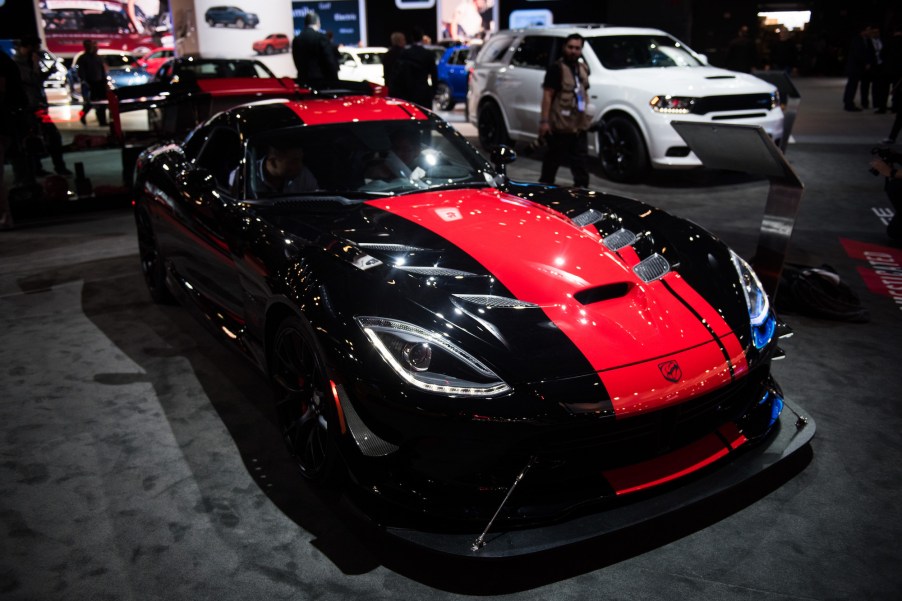
Only 1 Person Has Spent the Monster Cash to Buy a New Dodge Viper This Year (So Far)
The 25-year production run of America’s premier supercar, the Dodge Viper, ended when the last unit rolled off the line at the iconic Conner Avenue Assembly plant in Detroit, Michigan, on August 31, 2017, after its discontinuation by then-Fiat Chrysler Automobiles (FCA).
During its life, the Dodge Viper was a testament to the limits of what a manufacturer will put on sale. As a car originally sold without windows, door locks, air conditioning, anti-lock brakes, or a roof, it provided an option for those who thought the Corvette was a bit too boring.
The Viper stood as a worthy, rebellious competitor to overseas rivals, but reverence for the renegade waned over the years. True to its nature, it fought to the production grave shouting “no replacement for displacement” as a manually-shifting, rear-wheel drive, high-downforce road car for a bargain.
Can you still buy a Dodge Viper?

Although production ended nearly five years ago, you can still buy a brand-new sledgehammer of a Viper with the shock-and-awe performance of a V10. According to Jalopnik, the opportunity is primarily thanks to Gerry Wood Dodge in Salisbury, North Carolina, which bought 135 units in 2017 so the Viper would see the production line.
Edmunds shows that retail 2017 Vipers warrant a little over $133,000. However, one used listing on Autotrader is hitting the half-a-million-dollar mark.
Stellantis reported a Viper sale in June 2022
Inflated used market prices aside, new units are still being sold. In fact, according to Stellantis’ Q2 2022 sales figures, the company shifted one Viper in June.
Cars sold years after their production are known in the industry as “zombie cars,” and it’s not as uncommon as you may think. For example, Stellantis reported four new Vipers sold in 2021.
It’s unclear what model Viper was sold in June 2022 or who had the monster cash to throw down for one. It could have been one of the five special edition Vipers that rounded out its final model year.
2017 Dodge Viper performance specs and special editions
The Viper has come a long way from its austere yet lively beginning. Whereas the first-generation RT/10 was Chrysler’s Bob Lutz and Tom Gale’s modern image of a Cobra. The fifth-generation VX became more sophisticated in its melding of muscle car and exotic thoroughbred, becoming America’s example of the fastest road-legal track car imaginable.
With its muscularity sculpted by aerodynamics, the 2017 Dodge Viper is one of the last representations of analog supercar performance. What began with a Lamborghini-built, Chrysler LA V8-inspired 8.0-liter V10, over the years, it was punched out to 8.4 liters, producing a gut-pounding, naturally-aspirated 645 hp and 600 lb-ft of torque, pulling to its 6,200 RPM redline.
With fully-adjustable Bilstein dampers, a lot of the handling setup is left to the drivers. With a power-to-weight ratio of 425 hp per ton, the Viper ACR held 13 track records, more than any production car in the world at the time.
According to Motor Authority, the 2017 Dodge Viper was available in the following models and special editions:
- Viper SRT
- Viper GTC
- Viper GTS
- Viper ACR
- Viper 1:28 Edition ACR
- Viper GTS-R Commemorative Edition ACR
- Viper Snakeskin Edition GTC
- Viper Snakeskin Edition ACR
- Viper Voodoo II Edition ACR
- Viper Dodge Dealer Edition ACR
What killed the Dodge Viper?
The Dodge Viper stirred the souls of automotive enthusiasts when the concept was released at the North American International Auto Show in 1989. It even caused a revolt before the 1991 Indy 500 when the United Auto Workers Union caused enough commotion for its quick replacement, an RT/10 driven by Carroll Shelby.
The union was upset that the Japanese-built Dodge Stealth was picked to be the pace car. After its Indy debut, orders went through the roof. The team hitherto focused on pumping out unmistakably boring “Kei” cars, and minivans rejoiced in designing and building an action thriller on wheels.
No more than 1,000 Vipers per year sold following 2008, Carsalesbase.com shows. As sales dwindled and the company put out the best performing model in the fifth-gen VX, it wasn’t well-publicized poor sales numbers that did in the Mopar supercar. Future safety requirements played an essential part. According to AllPar, Federal Motor Vehicle Safety Standard (FMVSS) #266 required all new cars to have side curtain airbags to mitigate ejection, which the Viper’s architecture didn’t support.
Regardless, the Viper’s ergonomically tight cockpit, lack of luxury interior, and impracticality could have been why buyers didn’t storm FCA in Auburn Hills to demand a redesign for the Viper’s longevity. Moreover, in a country where “fast” isn’t measured in corners but stop light to stop light, the retro reimagines of the Charger and Challenger packing pavement-rattling V8s and functional backseats have proven a much better money maker for the company.


